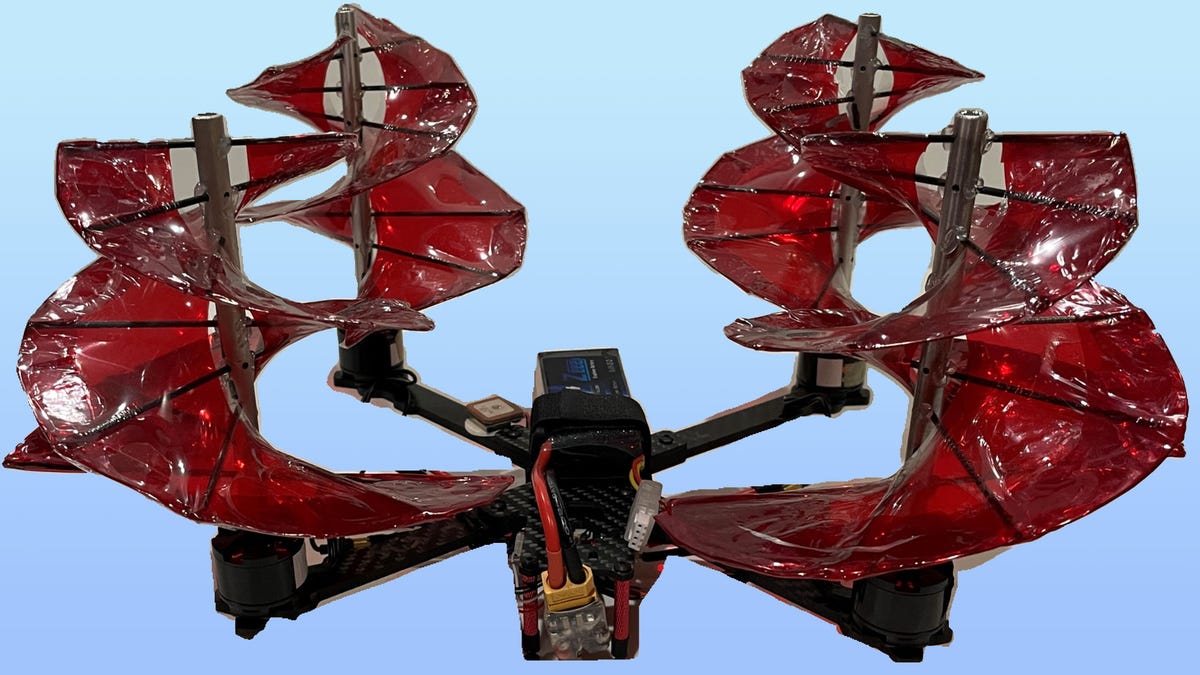This drone flies using da Vinci's 530-year-old helicopter design
Leonardo's aerial screws actually can work when built with modern materials, University of Maryland engineers find with a drone called Crimson Spin.

The aerial screws Leonardo da Vinci sketched in the 15th century now power a small drone.
In the late 1480s, Leonardo da Vinci sketched out a clever design for a one-person helicopter propelled by an "aerial screw." You may have seen his drawings and wondered whether one of the choppers could ever take flight.
Now we know the answer. The Italian genius was right.
Starting in 2019, a University of Maryland engineering team designed and tested the underlying technology as part of a design contest. Then over the last year and a half, team member Austin Prete built Crimson Spin, an unmanned quadcopter drone using da Vinci's screwlike design, and flew it on several brief journeys.
"I was absolutely surprised it worked," said Prete, a graduate student in the university's aerospace engineering department who built the aircraft for his master's degree. He and other team members were Initially skeptical but grew more excited by da Vinci's design after some computer simulations and 3D-printed screw prototypes showed promising trends.
He presented his results -- and the first video of the aircraft flying -- at the Transformative Vertical Flight 2022 conference in San Jose, California, last week.
The project is a good example of how current technology is diverging from conventional airplane and helicopter design even though it's highly unlikely a 15th century flying corkscrew will deliver an Amazon package anytime soon. The conference featured a collection of exotic aircraft that can take off vertically like a helicopter, then fly horizontally like an airplane. Companies like Kitty Hawk, Airbus, Transcend Air and Jaunt hope they'll revolutionize shipping and whisk people around in air taxis.
Although Prete built only a small drone, the technology could work with an aircraft big enough to haul a human. "I do believe it should be able to scale up fairly well," he said.
Modern materials
Artist and inventor Leonardo da Vinci drew this aerial screw design in the late 1480s.
The Maryland grad student benefited from materials da Vinci couldn't get.
State-of-the-art Renaissance era construction materials, such as wood and leather, are too dense for aircraft. Da Vinci also didn't have compact energy sources.
Prete had access to aluminum, plastic, electric motors, batteries and computer control systems that made the aerial screw design possible. Also helpful: computer-aided design and computational fluid dynamics software that Prete used to design prototypes and simulate aerodynamics inside a computer.
Today's quadcopter technology also helped make the design practical. These are steered by subtle changes to propeller speed that tilt the aircraft one way or another. It would have been much more complex to try to build a single-shaft design like a conventional helicopter, Prete said. Helicopters use complex gearing and controls to continuously adjust the tilt of each rotor as it spins.
There are plenty of challenges, though, including the aerial screws' greater weight and potential for instability.
Novel aerodynamics
Prete discovered that some weird aerodynamics likely helped keep Crimson Spin aloft.
Delta-wing aircraft -- those with big triangular wings like the supersonic Concorde -- produce a twisting vortex of air just past the leading edge of the wing. That vortex creates a low-pressure zone that can increase lift. Simulations show that a similar vortex forms along the outer rim of the aerial screw's flat surface, spiraling down the entire structure and applying an upward thrust, Prete said.
One result of these aerodynamics is that the aerial screw produces less downwash than conventional propellers. That means less dust, grit and other blowing material underneath, Prete said. It's probably quieter too.

